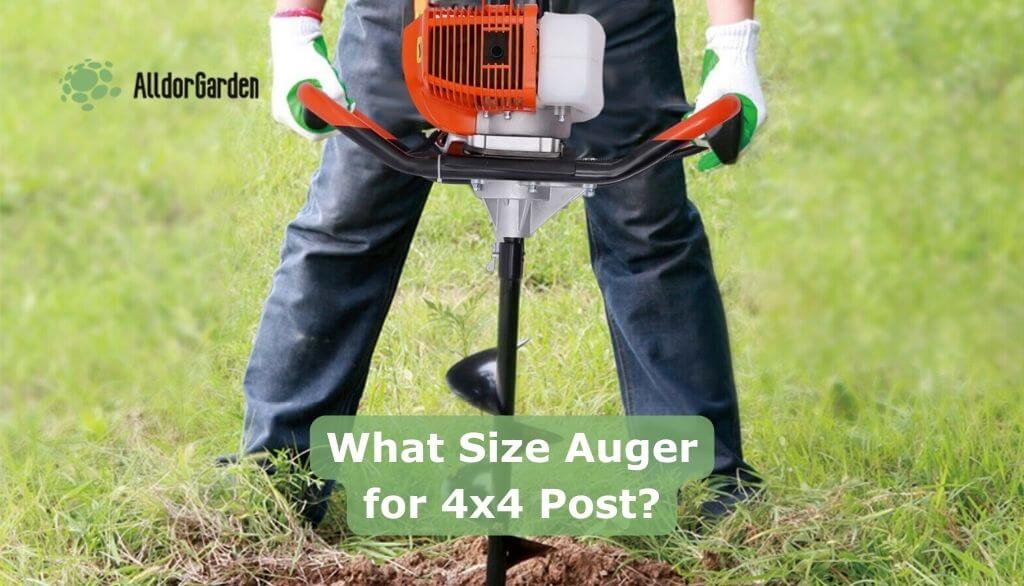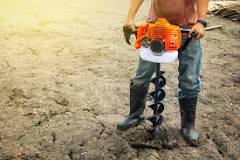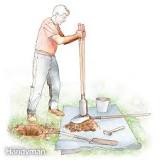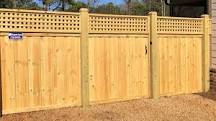Installing a fence can be a great way to add privacy, security, and curb appeal to your property. However, it’s important to ensure that the fence posts are installed properly to ensure the fence is stable and durable.
One of the key considerations when installing fence posts is the size of the auger needed to drill the holes. In this blog post, we will explore the factors that impact the size of the auger needed for a 4×4 fence post.

How to Choose the Right Auger Bit Size for Drilling Holes for a 4×4 Fence Post?
Using a too-small bit can result in wobbly posts, while a too-large bit can create holes that are too wide for the post to fit snugly, compromising the fence’s strength.
Typically, a 8-inch diameter auger bit is recommended for drilling holes for a 4×4 fence post. This size allows enough space for the post to fit snugly while providing enough room for the concrete to set and secure the post firmly in place. However, it’s important to keep in mind that the actual size of a 4×4 post may vary slightly, so it’s always best to measure the post before selecting the auger bit size.
How Deep Should You Drill Holes for Fence Posts?
When it comes to building a fence, drilling holes for the fence posts is a crucial step that can impact the stability and longevity of the fence. One important factor to consider when drilling these holes is the depth of the hole. The hole needs to be deep enough to provide sufficient support for the fence post but not so deep that it becomes unstable.
As a general rule of thumb, the hole should be at least one-third the length of the post. For example, if you are using 8-foot long posts, the hole should be at least 2.5 to 3 feet deep. This depth provides enough support for the post to withstand the weight and pressure of the fence, as well as any external factors such as wind and weather.
The hole should be wide enough to allow for proper placement of the post and for the concrete to set, typically around 8-10 inches in diameter.
Soil Type Affects Auger Bit Size for Fence Post Holes
In general, harder soils such as clay or rocky soils may require a larger auger bit to effectively drill the hole. This is because the soil is denser and requires more force to penetrate. Using a larger auger bit can help ensure that the hole is drilled to the proper depth and diameter needed for the fence post to fit securely.
On the other hand, softer soils such as sandy soils may require a smaller auger bit. This is because the soil is less dense and easier to penetrate. Using a smaller auger bit can help prevent the hole from becoming too large, which can compromise the stability of the fence post.
It’s important to note that soil type can also impact the amount of concrete needed to secure the fence post. For example, a fence post in clay soil may require more concrete than a post in sandy soil due to the denser nature of the soil.
Fence Type Affects Auger Bit Size for Fence Post Holes
A heavier fence such as a solid wood or metal fence may require a larger auger bit to ensure that the posts are stable and can support the weight of the fence. Using a larger auger bit can help ensure that the hole is drilled to the proper depth and diameter needed for the fence post to fit securely and withstand any external factors such as wind and weather.
On the other hand, a lighter fence such as a vinyl or chain link fence may require a smaller auger bit. This is because the fence posts are typically lighter and require less support from the soil. Using a smaller auger bit can help prevent the hole from becoming too large, which can compromise the stability of the fence post.
It’s important to note that the spacing between fence posts can also impact the size of the auger needed. For example, if the fence posts are spaced further apart, a larger auger bit may be needed to ensure that each post is stable and can support the weight of the fence.
Safety Precautions for Using an Auger for Fence Post Holes
Using an auger to drill fence post holes can be a quick and efficient method, but it’s important to prioritize safety when operating this tool. Users should be aware of potential hazards and take necessary precautions to prevent accidents.
First and foremost, it’s important to wear appropriate personal protective equipment (PPE) when using an auger. This includes gloves, eye protection, and sturdy work boots. Gloves can protect your hands from blisters and cuts, while eye protection can prevent debris from entering your eyes. Sturdy work boots can provide better traction and prevent injuries from falling or slipping on uneven terrain.
It’s also important to carefully read and follow the manufacturer’s instructions for operating the auger. Familiarize yourself with the controls and ensure that the tool is in good working condition before use. Never modify the auger or attempt to repair it while it’s still in use.
When operating the auger, keep bystanders and pets at a safe distance from the work area. Make sure that the area is clear of any underground utilities such as gas or power lines. Contact your local utility companies to mark the location of any underground lines before you begin drilling.
Lastly, always be mindful of your surroundings and stay alert while operating the auger. Avoid using the tool in inclement weather conditions or on steep or uneven terrain. If you encounter any issues while using the auger, immediately stop and assess the situation before proceeding.
Pros and Cons of Alternative Methods for Installing Fence Posts
While using an auger is a popular and efficient method for drilling fence post holes, some readers may be interested in alternative methods such as using a post hole digger or digging by hand.
Post hole diggers, also known as clamshell diggers, are handheld tools that can be used to manually dig fence post holes. They are relatively inexpensive and can be easy to use, but they do require significant physical effort and can be time-consuming, especially for larger projects. Additionally, post hole diggers may not be suitable for certain soil types such as rocky or clay soils, which can make digging difficult or even impossible.
Digging by hand is another alternative method for installing fence posts. It’s a cost-effective option that doesn’t require any specialized equipment, but it’s also labor-intensive and time-consuming. Digging by hand can be especially challenging in hard or rocky soils, which can require significant physical effort and may even require breaking up the soil with a pickaxe or other tool.
When comparing alternative methods with using an auger, it’s important to consider the size and scope of the fencing project. For smaller projects, such as a garden fence, using a post hole digger or digging by hand may be a practical option. However, for larger projects such as a perimeter fence, an auger may be a more efficient and time-saving option, especially when dealing with hard or rocky soils.
Weighing the Costs of Using an Auger for Fence Post Installation
In addition to the initial cost, there may be additional expenses such as fuel and maintenance to keep in mind.
The cost of purchasing an auger can vary depending on the size and type of auger needed. Handheld augers can range from $50 to $100, while larger, gas-powered augers can cost upwards of $500. Renting an auger can also be an option, with rental costs typically ranging from $50 to $100 per day.
When considering the cost of using an auger, it’s important to also factor in any additional expenses. Gas-powered augers require fuel, which can add to the overall cost of the project. Maintenance costs should also be taken into account, such as replacing parts or blades, and routine maintenance like oil changes and tune-ups.
While the initial cost of purchasing or renting an auger may seem high, it’s important to consider the time-saving benefits that come with using one. Using an auger can significantly reduce the time and physical effort required to dig fence post holes, which can make it a more efficient and cost-effective option in the long run, especially for larger projects.
How to Use an Earth Auger to Drill 4×4 Fence Post Holes?
FAQs
How Big of an Auger Do I Need for a 4×4 Post?
What Size Hole Should I Drill for a 4×4 Post?
How Deep to Dig for a 4ft Fence?
Should Fence Posts Be Concrete or Not?
Conclusion
Choosing the right size auger for a 4×4 fence post is crucial for ensuring the stability and durability of the fence. The size of the auger bit, the depth of the hole, the type of soil, the type of fence being installed, safety considerations, and cost are all factors to consider when selecting the appropriate size auger.
By taking these factors into account and following best practices, users can ensure that their fence posts are installed correctly and that their fence is stable and durable for years to come. By using the correct size auger, users can avoid costly and time-consuming repairs due to unstable or weak fence posts, saving time and money in the long run.






